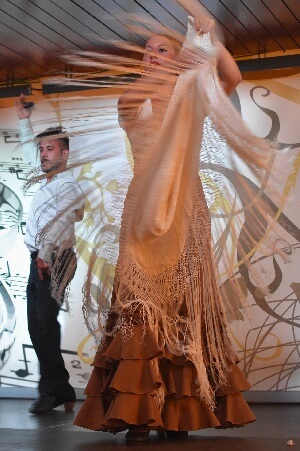What do Flamenco dancers wear?
The art form of Flamenco, which originates in the folkloric traditions found in Southern Spain in the Andalusia, Extremadura and Murcia regions, and which has developed for at least two centuries into a wide-spanning cultural phenomenon, has nonetheless over the years held on to a distinct essence.
Whether it is the music which this tradition has inspired, or the dancing, there is an unmistakable and inimitable aesthetic to flamenco which cuts right to the root of its history. Fundamental, then, to the flamenco experience is the clothing that is worn by the dancers.
Although the general style has remained the same, the dress code has through the ages been expanded upon, with the outfits becoming increasingly ornate as the tradition has evolved. So, if you are keen on getting into the spirit of flamenco dancing, then an important step is learning about the sartorial side of things.

Female dancers
There are a few different options for female flamenco dancers, with the outfits usually being characterised by an elaborate nature. Plenty of red and black patterns are to be expected, though with other colours also included in certain variants, and in terms of materials you will usually see a lot of cotton and lace being used.
Bata de Cola
Possibly the most extravagant of the lot for women comes in the form of the Bata de Cola outfit. A single piece with a snug waist, this has the selling point of a mesmerizing, long, flowing trail of ruffles. This is traditionally moved along in time with the rhythm of the dance, but, for this reason, it does make this dress rather heavy and difficult to manoeuvre, and therefore it is usually reserved for only the most experienced of dancers.
Traje de Flamenca
The Traje de Flamenca is similarly designed to the Bata de Cola, but it is not quite so long, only reaching down to the ankles. It has ruffles trailing down from the thighs as well as on the sleeves, and it can come in a variety of different designs, from polka dot patterns to simple solid colours. It can also be long or short sleeved. Traditional dancers would combine this costume with a mantle draped over their shoulders, and would opt for having their hair swept up in a bun.
Blouses
The blouse is another option for female flamenco dancers which, once again, can come in a variety of forms. The sleeves for example can range from full arm length to elbow length and can also sometimes come with ruffles. The neckline similarly can have a few different shapes, from sweetheart to v-necked to round. One benefit of some blouses is that some tops come with an inner layer which absorbs perspiration and keeps the dancer more comfortable.
Skirts
The different skirts available can more or less be divided into two types: those for performance and those for practice. Performance flamenco skirts are usually multi-layered and, as a result, quite expensive, whereas practice skirts will be single layered and therefore not as pricey. Nevertheless, what they will generally have in common is a tight waist and then a wide flare down to the feet so as to allow enough width to accommodate dancing steps.
Male dancers and general accessories
Male dancers have far fewer options when it comes to what to wear when flamenco dancing. So this is good news or bad news depending on whether you deal well when faced with lots to choose from! The normal costume though will comprise of a shirt underneath a short black jacket or vest. The trousers are also traditionally black, and also tight-fitting. On top of this, sometimes, a scarf or hat might be incorporated into the costume for extra flair. The hats are usually straw or Cordoba Hats.
These accessories are all part of the elaborate, extravagant visual aesthetic which further expresses and adds to the passionate and exuberant style of the dance. Men also might have castanets secured to their thumbs to add a percussive element to the dance in combination with the shoes that for men and women, thanks to metal which is driven into the bottom, make a clicking sound with each step.
Other accessories include the manton, which is used by women and made from silk, similar to a manila shawl, and is to be worn over skirts. In performance, women also hold fans decorated with lace, and decorate their hair with flowers, all of which accentuates the grace of the movement.
